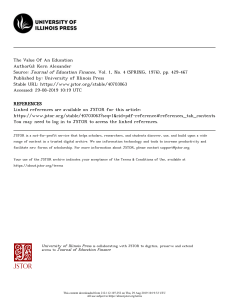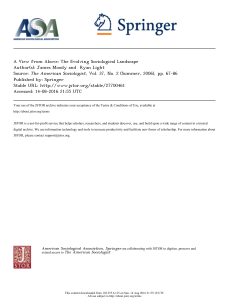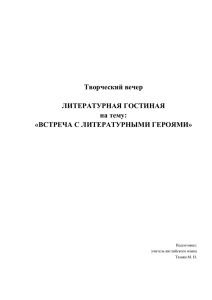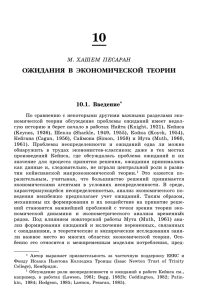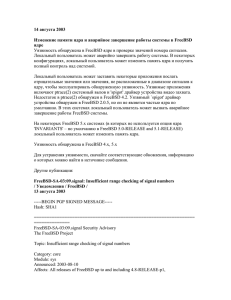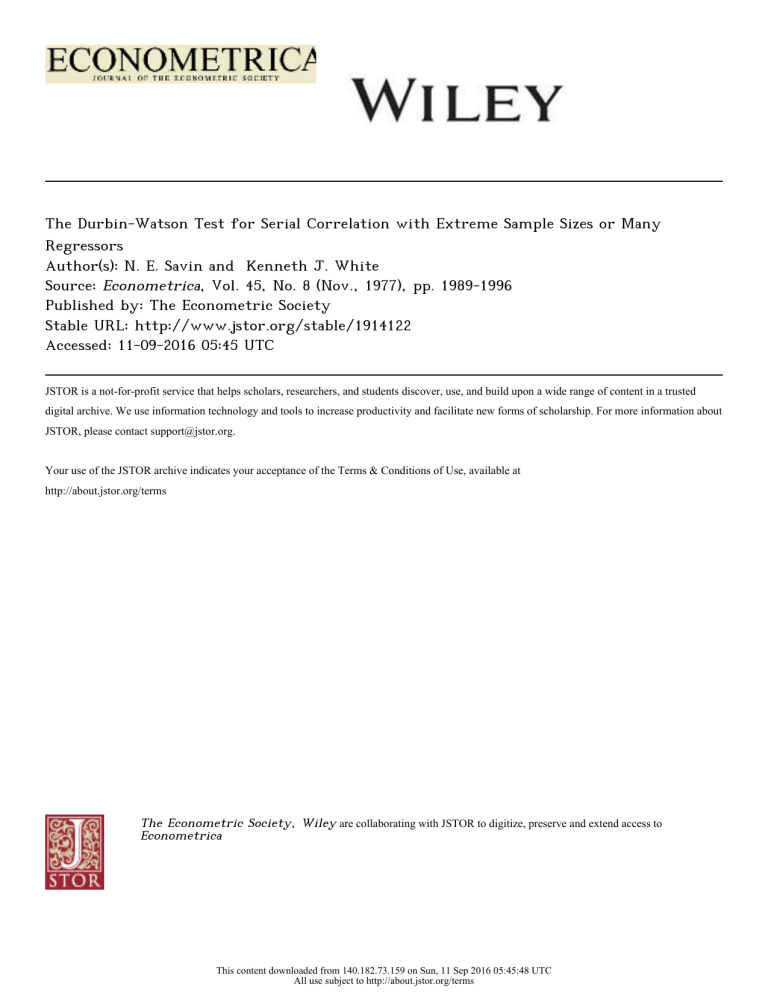
The Durbin-Watson Test for Serial Correlation with Extreme Sample Sizes or Many Regressors Author(s): N. E. Savin and Kenneth J. White Source: Econometrica, Vol. 45, No. 8 (Nov., 1977), pp. 1989-1996 Published by: The Econometric Society Stable URL: http://www.jstor.org/stable/1914122 Accessed: 11-09-2016 05:45 UTC JSTOR is a not-for-profit service that helps scholars, researchers, and students discover, use, and build upon a wide range of content in a trusted digital archive. We use information technology and tools to increase productivity and facilitate new forms of scholarship. For more information about JSTOR, please contact [email protected]. Your use of the JSTOR archive indicates your acceptance of the Terms & Conditions of Use, available at http://about.jstor.org/terms The Econometric Society, Wiley are collaborating with JSTOR to digitize, preserve and extend access to Econometrica This content downloaded from 140.182.73.159 on Sun, 11 Sep 2016 05:45:48 UTC All use subject to http://about.jstor.org/terms Econometrica, Vol. 45, No. 8 (November, 1977) THE DURBIN-WATSON TEST FOR SERIAL CORRELATION WITH EXTREME SAMPLE SIZES OR MANY REGRESSORS' BY N. E. SAVIN AND KENNETH J. WHITE This paper presents extended tables for the Durbin and Watson [3 and 4] bounds test The tables can be used for samples with 6 to 200 observations and for as many as 20 regressors. 1. INTRODUCTION Recent studies by Durbin and Watson [5], L'Esperance and Taylor [10], Koerts and Abrahamse [8], Tillman [15], Vinod [16], Savin and White [14] and others have shown increasing interest in the test of autocorrelation based on the d statistic proposed by Durbin and Watson [3 and 4]. The focus of these papers has been the computation of the exact distribution of d and the power of the test based on d. The exact distribution of d has been developed by Imhof [7] and Pan Jie-Jian [12]. However, few of the generally available computer programs for regression analysis incorporate these methods,2 possibly because of computational costs, particularly for large samples. With the Durbin and Watson [4] tables the bounds test is restricted to time series regressions with 15 to 100 observations and a maximum of 5 regressors in addition to unity. Often regression studies do not meet these restrictions since samples with less than 15 observations commonly occur with annual time series and regressions with more than 5 regressors are often found in the context of simultaneous equations and of distributed lags.3 In this paper we present extended tables for the bounds test. Our tables can be used for samples with 6 to 200 observations and for as many as 20 regressors. 2. THE DISTRIBUTION OF THE d STATISTIC Consider the regression model y = X3 + ?- where y is an n x 1 vector of consecutive observations of the dependent variable, X is an n x k matrix of observations of k fixed regressors, and s is an n x 1 1 This paper was completed while the authors were visiting at the University of British Columbia in 1975-1976. We would like to thank James Durbin, Geoffrey Watson, Gene Golub, Wilford L'Esperance, Hrishikesh Vinod, Chinh Le, and Ernst Berndt for helpful discussions and assistance. We would also like to thank the University of British Columbia for its generous support which made this paper possible. 2 One such program is SHAZAM, written by White [17] which incorporates both the Imhof an Pan Jie-Jian methods and uses a computational procedure suggested by Golub [6] which is outlined in Savin and White [14]. 3 Durbin [2] has shown that in the case of simultaneous equations the appropriate number o regressors for the bounds test is the number of exogenous variables in the system and not the number of right-hand variables in the structural equation being estimated. Clearly, the number of exogenous variables in the system can easily exceed 5. This point, which is frequently overlooked, was noted by Berndt and Christensen [1], but they were unable to carry out the bounds test with the existing Durbin and Watson tables. 1989 This content downloaded from 140.182.73.159 on Sun, 11 Sep 2016 05:45:48 UTC All use subject to http://about.jstor.org/terms 1990 N. E. SAVIN AND K. J. WHITE normally distributed disturbance vector. It is assumed that X has full rank k and that the elements of one of its columns are all unity. The d statistic is defined as d = e'Ae/e'e where e = [I - X(XXf'X']s = Me is an n x 1 vector of least squares residuals and where A is the usual successive difference matrix. The distribution of d depends on X since it involves the roots of MA. Durbin and Watson found a pair of bounding random variables dL and du with distributions involving only the roots of A and tabulated their lower tail significance points in [4]. Originally Durbin and Watson [4] computed the tables by hand using an approximation based on the beta distribution and Jacobi polynomials. This required interpolation in Karl Pearson's Tables of the Incomplete Beta Function [13]. Imhof [7] presented an exact method for computing the distribution of quadratic forms in normal variables. Koerts and Abrahamse [8] used the Imhof method to recalculate the significance points of the bounding random variables dL and du. Vinod [16] also used the Imhof method to generalize the bounds test for higher order autoregressive processes. Pan Jie-Jian [12] used the results of his earlier paper [11] to develop an alternative to the Imhof method. A proof of the Pan Jie-Jian method is given in Durbin and Watson [5]. Recently, L'Esperance, Chall, and Taylor [9] have suggested a method which employs complex integration. Our extended tables are presented below. All computations were performed in double precision Fortran on an IBM 370-168 computer. For sample sizes less than 15 we found the Pan Jie-Jian method to be computationally efficient compared to the Imhof method. This confirms the experience reported by Durbin and Watson [5]. For sample sizes 1 5 to 100 and up to 5 regressors in addition to unity our tables are taken from Koerts and Abrahamse [8]. For 6 to 20 regressors and up to 80 observations we employed the Pan Jie-Jian method. All entries for more than 80 observations are computed using the Imhof method. While either method may be used we recommend the switch to the Imhof method at 80 observations on the basis of our computations. The computer programs which implement the Imhof and Pan Jie-Jian methods involve the numerical analysis of certain integrals. The accuracy of the computations is a function of the step size and truncation error. These were set in order to obtain at least three digit accuracy past the decimal point. For values of n not shown in the table, we suggest linear interpolation which should yield an accuracy of two digits past the decimal point. It is worth remarking that in a few cases the Imhof program failed to converge when the d statistic was equal to the value of one of the roots of A. Finally, we note that the computations required for large values of n were extremely heavy, thus making any further extension of the tables impractical. This content downloaded from 140.182.73.159 on Sun, 11 Sep 2016 05:45:48 UTC All use subject to http://about.jstor.org/terms DURBIN-WATSON TEST 1991 In examining the critical values of the bounds test it is instructive to also consider the minimum and maximum roots of the A matrix since these represent the minimum and maximum values of the d statistic. The minimum and maximum values of the d statistic for selected sample sizes are presented in Table I. For small TABLE I THEORETICAL RANGE OF d STATISTIC n Minimum Maximum 2 3 2.0000 1.0000 3.0000 4 .5858 5 .3820 10 .0979 15 .0437 30 .0110 50 .0039 100 .0010 200 .0002 300 .0001 3.4142 3.6180 3.9021 3.9563 3.9890 3.9961 3.9990 3.9998 3.9999 500 .0000 2.0000 4.0000 sample sizes the inconclusive region is large relative to the range of the d statistic which suggests that an exact test may often be required. Trinity College, Cambridge and Rice University Manuscript received June, 1976; revision received December, 1976. This content downloaded from 140.182.73.159 on Sun, 11 Sep 2016 05:45:48 UTC All use subject to http://about.jstor.org/terms 1992 N. E. SAVIN AND K. J. WHITE TABLEI 90.58 (13P2790.8'U- DURBIN-WATSOC:1PEGIFANOTSdLDW' 10.6539"27 8.03'51249- 130.78624950.31P628490.3182- 201.6893 701.6 239751.6082 71.59 150.63798 1.67593810.729315.867 10.52693810.26 8710.693718.56 951.02873691. 8250361.987531.6 901.86547321.89603 1.687 321.769 851.29 345781.60 32971.68 2731. 801.6594 1.687305942.8163 57.29183 751.48902371.689031.28697 1.85 701.4298 361.978 2361.58079241.6 651.407839 1.6823091.68720931.8 601.389547201.83945 1.637982410.78 51.3642708 91.U20 76381.490 781.3 501.324896 1.203857691.02378 50.9164 891.2P3764018.92 065183.97 021834.9 801.24639 871.05 94620.81759 6. 391.278 931.078 2690.317820.197 381.27069 81.720"968.1370 89.51 371.2 69,8 1.0 986520.17 839 0.21 361.20957821.0439)521.687903 1.278 391.078 4391.207861.9087 .6923 381.2960 78431.2950 67.83109 257.6 31.729803.619)58730.1698 750.612 321.60879541.20 795861.0 R7349681.502 31.87290 .6197083.2179068.5213 301.26791840.57R~6812.09 62.8105 291.843501.92 860719.23 58706.3219 281.043796"80.1327690.183 6290.4 271.0893 40.8719 6230.197 3620.89 261.07 39810.5763 90.41R726580.413 251.098360.15298670.1542930.6 241.037968240.19576820.;1"45798320.1 231.087Q940.15367280.1943 280.79 20.9718 340.79156 .849051237 6.80254 210.9768 30.719562 '0.478592310.685 20.9518763'04.951783 0.4621 38950.271 190.28356741C.0P896713.20957.16283 180.9265781.0u236495 .82013 .846721905 170.82 9561430.S78 9q20Q31.467928013.5 160.8 732596C.10837 92.r,160829.31 150.8729460.Q81739240.6518730.6 180.7692510.47938250.1672983- 1207.69354a019.728346059-.12 3O io0.6"137290.6- 80.497135P2- 70.4351629- 60.39142- ndLOIui]oUdL08JOt k6=1I2'0 95786=qCkI10 This content downloaded from 140.182.73.159 on Sun, 11 Sep 2016 05:45:48 UTC All use subject to http://about.jstor.org/terms DURBIN-WATSON TEST 1993 ak'isthenumbrofgxcldp. 201.567983 241.650798 413.62 150.47389 21.40863579 1 10.3479286 51.039248761 951.2073684 19.057362 1.0954 901.26478 5 1.69748 021.647 851.23604 891.32065 1.27804 801.2574 93061.825793 751.0894632 .094632157 701.3896 51.0974238 0.14927 651.0874392 0.57186230.97 601.3785942 0.1873652 50.9718426350.17842 90.63571 50.913287 640.52318764 450.831972 C65.01234785.61 40.7239615 0.8247615 380. 390.725614 382.05746938.12 380.726514 .082514637 .9 370.682915C40.7326895 0. 360.5821 4 0.9261378 4 350.6421879 30.52671980.3 340.6125 7890.3261 57 30.5821796,4 30.28754691 320.58164920.3761 8452 310.524876 930.2514,768 3 30.528479 60.5248317 60.9 290.4731568 2.4097136 8.450 280.436795 0.146392 85 270.413956 870.13245 96 260.3814 7590.143275 68 250.3481796 523.01748695.23 240.3158679 20.3651497- 230.81657 9 0.31745692- 20.46791835 0- 210.8763495C - 20.178943 60.89- - This content downloaded from 140.182.73.159 on Sun, 11 Sep 2016 05:45:48 UTC All use subject to http://about.jstor.org/terms 190.453276- 180.34675- 170.843265- - 160.34- ndLUOt'I S k'-1=234567890 1994 N. E. SAVIN AND K. J. WHITE 80.76312590.687 TABLEI 120.9738561.40273956.82017349 13.048652.71 049.5230869.25014736 DURBIN-WATSO C:5PERNTSIGFAOrdLNDUa 10.9273458691.2048365.20 - - 90.824136 52.18096- - 201.758 4931.7280 1.783694 1.527863 4 150.7246 193.74685102. 763812.40659187 10.6549371 .65928170.5328160.54871629 951.648723091.57 81.3502 74891.56 42903 901.63572 891.657421.80942761.85 4209 851.62470951.207451.8047291.5 86391 801.6258601.734 5721.80 453 21.86973 25 751.9862 05431.79 8701.45e 28391.67 0395 701.58364 251.70349 681.30247691.83 05948 651.7293 501.6473861.04537861.2093E64 601.549 2801.6947861.3205891.42603 98 51.286049 521.8473681. 429 531.029710 501.38462 1.738251.982467510.93 861024 451.7630 81.6 720 1.3859 1.802 3 401.2539681.52730861.5429061.7829451 391.45082731.65 28791.6504327.908532164 381.4275 9318.65270419.68 39102.7 89120 371.49506 371.5249Ilqo71.380 9412.05 891 361.452 8791.65423 791.480537912.40 8621 351.4029 831.65270831.94 67012.5984 236 341.95 80271.65 8410. 95702.6981 257 31.8502781.659302781.6904127.856 0921 321.7509421.65073981.04 72 904.18362790 31.64927501.6 73509182. 5018792. 60413 301.52489 671.504397180.3926485.1072 36 291.348705619.24730518.9402586.147320896 281.34765018. 4702815.9 7420198. 3065241 271.36490512.684753016.9274850362.194067 261.304 513.620759183. 2061735.4 2908153 251.8406 123.54876091.278410.2641950 214.7368510. 3759210.837521406.8 506213 231.57468 01.96785 20.46175802.34516270 21.39475031.64987 0.692 74058. 27143 21.40538126.907 8164.32079542.613086 201.4 5370981.6427910.625390.14627385 19.804753691.80 47523.69042 56.890372 4 18.539046 .190827. 603257.461027.38047 17.38056.971 0.64215380.27560.2971834 16.0379825.1703495.6217038.926408.390154 15.073694 81.75069 20.47 32 51.970326 48 14.0539 1.76 032 .5960827. 4031.276- 10.879326410.5 376240.8- - - 70.1356489- -_ - 60.14- _ _- This content downloaded from 140.182.73.159 on Sun, 11 Sep 2016 05:45:48 UTC All use subject to http://about.jstor.org/terms dLU driLU l k'-1=2345k'6=78910 DURBIN-WATSON TEST 1995 170.38 5- ak'isthenumbrofg xcldintherp. 190.2356 407.2- 201.6583921.0869 31.508*176I.95 41 150.79826',153).90 4156.0972814.065231840 10.438926510.743-21.06351280.7 53129.68 951.0482 63701.98452C 0(1.96827 0.16 59728 901.3576 041.95382 01.6952 3.1087296 851.369042715.98206731. 520917. 2061 801.34957 283.0(15923.15 62 I3.01,28765 751.309 267.04315289.31562 09.315827 701.298P63 02.176390(8.152 73082.51 -97362 651.23094162.03 851.02967802.3941 601.8234579106.2 370.928513 .A20874 936 51.29067 (52.103 96f;.28103796.82045 17. 501.642390.725 89.306241(79 0.53261 .7 450.982163 7.908236 9.7051268 .905273 8 40.8962 3I0785.124367850. 1275.80 92437 390.875261 3.04729653.0714925.08319240. 380.5267913.048625 10a.7352904.8263705 370.8125 70.652 '04.8739520.397 510 360.827960.23157680.2 4172.96035 142 350.782 462.510 9(72.604q81392.0 539.210 340.758269a304.5726(18.'50249.5031270.634 30.71286940.58629A70.389 23.1089 23 320.71685 2.017359.026359.1023 8 310.672 8504.6 275980.3617 293.08 16 30.627591.0823970.526318.095613 290.615 3792.0(1P83592.0173928.016439528 280.57 16052.839 05.271368 0.32184950 270.56 3092.85471320.8 9413.602581 260.58937 2.1035679.2031 .5087362 4 250.7 4352.98071 35.27601983.65702419 280.43176 92.053 196270.4351 70.683- 230.9186 753.20 1(9.03576 8.- 20.398715 20.6319580.2371- 210.37964 82.301e9583.70- 20.63 41590.3267- 180.732654 - This content downloaded from 140.182.73.159 on Sun, 11 Sep 2016 05:45:48 UTC All use subject to http://about.jstor.org/terms nLI=1dUk263L0=1dk5U6L7=1'k8dIL20 160.9835- - 1996 N. E. SAVIN AND K. J. WHITE REFERENCES [1] BERNDT, E. R., AND L. R. CHRISTENSEN: "The Translog Function and the Substitution of Equipment, Structures, and Labor in U.S. Manufacturing, 1929-68," Journal of Econometrics, 1 (1973), 81-114. [2] DURBIN, J.: "Testing for Serial Correlation in Systems of Simultaneous Regression Equations," Biometrika, 44 (1957), 370-377. [3] DURBIN, J., AND G. S. WATSON: "Testing for Serial Correlation in Least Squares Regression, I," Biometrika, 37 (1950), 409-428. [4] : "Testing for Serial Correlation in Least Squares Regression, II," Biometrika, 38 (1951), 150-178. [5] : "Testing for Serial Correlation in Least Squares Regression, III," Biometrika, 58 (1971), 1-19. [6] GOLUB, G.: Personal Communication, 1976. [7] IMHOF, J. P.: "Computing the Distribution of Quadratic Forms in Normal Variables," Biometrika, 48 (1961), 419-426. [8] KOERTS, J., AND A. P. J. ABRAHAMSE: On the Theory and Application of the General Linear Model. Rotterdam: Rotterdam University Press, 1969. [9] L'ESPERANCE, W. L., D. CHALL, AND D. TAYLOR: "An Algorithm for Determining the Distribution Function of the Durbin-Watson Test Statistic," Econometrica, 44 (1976), 13251326. [10] L'ESPERANCE, W. L., AND D. TAYLOR: "The Power of Four Tests of Autocorrelation in the Linear Regression Model," Journal of Econometrics, 3 (1975), 1-21. [11] PAN JIE-JIAN: "Exact Distribution of Quadratic Forms and Ratios of Quadratic Forms in Normal Random Variables," unpublished (written in 1962 and at present kept in the Probability Teaching and Research Group of the Department of Mathematics and Mechanics of Peking University). [12] : "Distribution of Noncircular Serial Correlation Coefficients," Selected Translations in Mathematical Statistics and Probability (printed for the Institute of Mathematical Statistics the American Mathematical Society), 7 (1968), 281-291. [13] PEARSON, K.: Tables of the Incomplete Beta Distribution. Cambridge: Cambridge University Press, 1948. [14] SAVIN, N. E., AND K. J. WHITE: "Testing for Autocorrelation with Missing Observations," Econometrica (forthcoming). [15] TILLMAN, J. A.: "The Power of the Durbin-Watson Test," Econometrica, 43 (1975),959-974. [16] VINOD, H.: "Generalization of the Durbin-Watson Statistic for Higher Order Autoregressive Processes," Communications in Statistics, 2 (1973), 115-144. [17] WHITE, K. J.: "A General Computer Program for Econometric Methods-SHAZAM," Econometrica (forthcoming). This content downloaded from 140.182.73.159 on Sun, 11 Sep 2016 05:45:48 UTC All use subject to http://about.jstor.org/terms

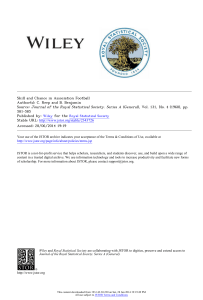
![[World Literature Today vol. 57 iss. 1] Review by John L. Brown - Varia Issue O What a Paradise It Seemsby John Cheever (1983) [10.2307 40138625] - libgen.li](http://s1.studylib.ru/store/data/006539985_1-681f9480cf85bfff054ed6b59fd6fc50-300x300.png)
